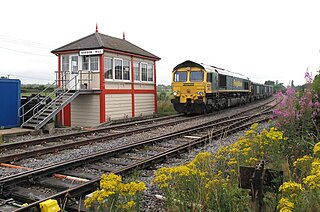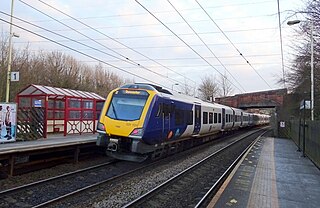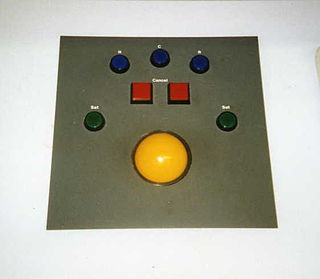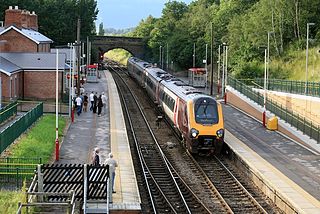
On a rail transport system, signalling control is the process by which control is exercised over train movements by way of railway signals and block systems to ensure that trains operate safely, over the correct route and to the proper timetable. Signalling control was originally exercised via a decentralised network of control points that were known by a variety of names including signal box, interlocking tower and signal cabin. Currently these decentralised systems are being consolidated into wide scale signalling centres or dispatch offices. Whatever the form, signalling control provides an interface between the human signal operator and the lineside signalling equipment. The technical apparatus used to control switches (points), signals and block systems is called interlocking.

York railway station is on the East Coast Main Line (ECML) serving the cathedral city of York, North Yorkshire, England. It is 188 miles 40 chains (303.4 km) north of London King's Cross and on the main line it is situated between Doncaster to the south and Thirsk to the north. As of June 2018, the station is operated by London North Eastern Railway. It is the busiest station in North Yorkshire, the second busiest in Yorkshire & the Humber, and the fifth busiest in Northern England. In Britain's 100 Best Railway Stations by Simon Jenkins, the station was one of only ten to be awarded five stars.

The Wakefield line is a railway line and service in the West Yorkshire Metro and South Yorkshire Passenger Transport Executive areas of northern England. The Wakefield line is coloured yellow on maps and publications by West Yorkshire Metro. The line was electrified in 1989, between Leeds & Wakefield Westgate, as part of the programme to electrify the East Coast Main Line.

The Dearne Valley line is the name given to a railway line in the north of England running from York to Sheffield via Pontefract Baghill and Moorthorpe. The route was built over several years and consists of lines built by several railway companies.

The Integrated Electronic Control Centre (IECC) was developed in the late 1980s by the British Rail Research Division for UK-based railway signalling centres, although variations exist around the world. It is the most widely deployed VDU based signalling control system in the UK, with over 50 workstations in control centres that manage many of the most complex and busy areas of the network.

Moorthorpe railway station serves the village of Moorthorpe and town of South Kirkby in West Yorkshire, England. It lies on the Wakefield Line and the Dearne Valley Line, 18+1⁄4 miles (29.4 km) north of Sheffield and is served by Northern.

Lincoln railway station serves the city of Lincoln in Lincolnshire, England. The station is owned by Network Rail and managed by East Midlands Railway. East Midlands Railway provides the majority of services from the station, with other services being provided by Northern and London North Eastern Railway. It is the busiest station in Lincolnshire, and the fifth busiest station in the East Midlands.

Knottingley railway station serves the town of Knottingley in West Yorkshire, England. It lies on the Pontefract Line, operated by Northern, and is 16 miles (26 km) south east of Leeds railway station.

Plumpton railway station serves the village of Plumpton in East Sussex, England. It is 44 miles 42 chains (71.7 km) from London Bridge via Redhill.

Thirsk railway station is on the East Coast Main Line and serves the market town of Thirsk, North Yorkshire, England. It is situated between York to the south and Northallerton to the north. Its three-letter station code is THI. The station is about 2 miles (3 km) outside of Thirsk town centre and is actually on the edge of the village of Carlton Miniott.

The Peterborough–Lincoln line is a railway line linking Peterborough and Lincoln, via Sleaford and Spalding. Between Lincoln and Spalding, the line follows the route of the former Great Northern and Great Eastern Joint Railway.

Church Fenton railway station serves the village of Church Fenton in North Yorkshire, England. It is situated where the Cross Country Route from Leeds to York meets the Dearne Valley line from Sheffield to York, just under 10.75 miles (17 km) from York.

Skipton railway station is a Grade II listed station which serves the market town of Skipton in North Yorkshire, England. It is a stop on the Airedale Line, which provides access to destinations such as Leeds, Bradford, Carlisle, Lancaster and Morecambe. The station is operated by Northern Trains and is situated 27 miles (43 km) north-west of Leeds; it is located on Broughton Road.

Truro railway station serves the city of Truro, Cornwall, England. The station is on the Cornish Main Line and is the junction for the Maritime Line to Falmouth Docks. It is situated at milepost 300.75 miles (484.01 km) from London Paddington, which is measured via Bristol Temple Meads, although most trains use the shorter route via Newbury.

SimSig is a mixed donationware and commercial Windows-based train simulator of modern railway signalling systems in Great Britain, from the point of view of a railway signaller. Users have also had success running SimSig on Linux using Wine.

Hellifield is a railway station on the Bentham Line, which runs between Leeds and Morecambe via Skipton. The station, situated 36 miles 17 chains (58.3 km) north-west of Leeds, serves the village of Hellifield, Craven in North Yorkshire, England. It is owned by Network Rail and managed by Northern Trains.

Doncaster PSB is a signalling centre on the East Coast Main Line (ECML) railway in the United Kingdom, principally covering the line from London to Edinburgh but also encompassing other lines diverging and converging to the ECML.

Solid State Interlocking (SSI) is the brand name of the first generation processor-based interlocking developed in the 1980s by British Rail's Research Division, GEC-General Signal and Westinghouse Signals Ltd in the UK.

A rail operating centre (ROC) is a building that houses all signallers, signalling equipment, ancillaries and operators for a specific region or route on the United Kingdom's main rail network. The ROC supplants the work of several other signal boxes which have thus become redundant.

York Rail Operating Centre is a Rail operating centre (ROC) located at the south western end of York railway station in York, England. The site is one of twelve that will control all signalling across the mainland of the United Kingdom. It was opened in stages from 2014 onwards, with responsibility for signalling becoming active in January 2015. The York ROC accepted the role of its predecessor, the adjacent York Integrated Electronic Control Centre (IECC), in December 2018.


















